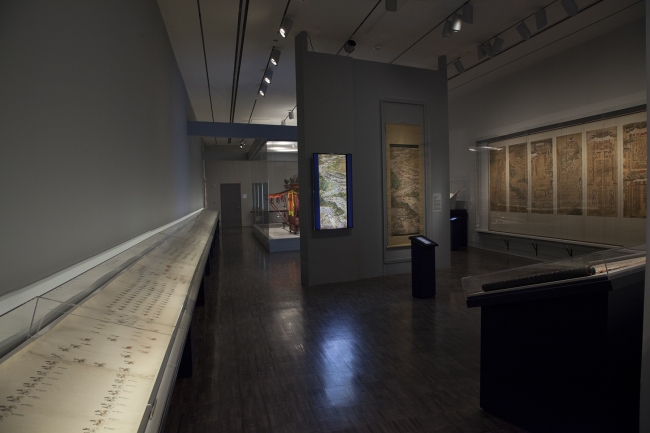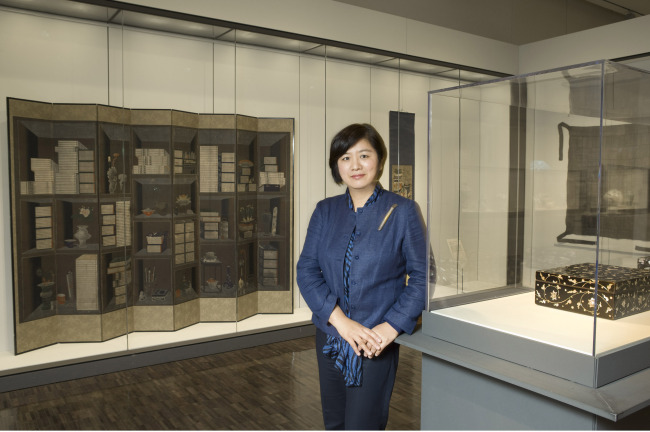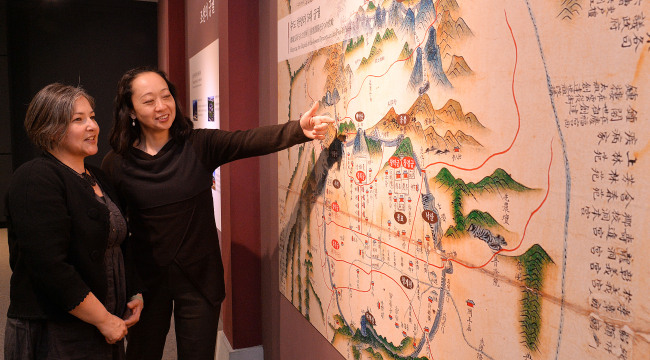The making of an exhibition
Museum experts talk about how an international art show is put together
By Korea HeraldPublished : Feb. 9, 2014 - 19:16

When Kim Hyon-jeong, associate curator of Korean art at Asian Art Museum ― Chong-Moon Lee Center for Asian Art and Culture, arrived at the San Francisco institution in the summer of 2010 after four years at the Los Angeles County Museum of Art where she had re-launched the Korean galleries, her assignment was already waiting for her.
The museum’s director Jay Xu had already decided on holding a Korean exhibition at the largest U.S. museum dedicated exclusively to Asian art and culture after visiting the “Scenes of Banquets and Ceremonies of the Joseon Period” at the National Museum of Korea in 2009: It was up to Kim to organize the exhibition three years later that would mark the 10th anniversary of the museum’s relocation to the current site.
“In Grand Style: Celebrations in Korean Art during the Joseon Dynasty,” held Oct. 25, 2013-Jan. 12, ended up taking quite a different direction from the original Seoul exhibition.
“For one, we have a very different audience,” said Kim during an interview with The Korea Herald at the National Palace Museum of Korea in Gyeongbokgung Palace on Jan. 27.
“About half the artifacts from the 2009 exhibition were changed to facilitate storytelling. This time there were many artifacts from the National Palace Museum of Korea.” All in all, artifacts from some 10 museums in Korea, including the National Museum of Korea, were brought to San Francisco.
“We avoided a textbook-like approach, choosing instead to go with a theme and a story,” said Kim. “It was a fun, interesting project for me.”

In 1989, the Asian Art Museum became the first museum in the United States to appoint a Korean art curator. However, the museum had not had a major Korean exhibition since 2003, when it held “Goryeo Dynasty: Korea’s Age of Enlightenment, 918 to 1392” to mark the museum’s opening at the new Civic Center location.
Divided into four sections ― “To be a King in the Joseon Dynasty,” “Royal Procession and Banquets,” “Women at the Royal Court” and “Life and Celebrations of the Elite” ― “In Grand Style” showed 110 artworks and objects, some 90 percent of them shown overseas for the first time.
While Joseon-period celebrations may have been a difficult subject for the average audience in San Francisco, the various interactive IT features made it easier for the visitors to engage with the displays.
“You could ‘flip’ through the pages of a book on exhibition by touching a display screen. You could enlarge sections of the painting of the Hwaseong parade to see up close the facial features of the figures. We had a very favorable response,” Kim said. The 46-meter-long “King Jeongjo’s Procession to His Father’s Tomb in Hwaseong,” an elaborate painting that depicts in minute detail the actual procession that took place in 1795, was, in fact, the biggest crowd puller.

The 11-week exhibition drew more than 40,000 visitors ― a number which Kim concedes is far less than that for the museum’s blockbuster shows such as its exhibition on Shi Huang Ti, the first emperor of China, but a number which she believes is significant nevertheless because the average audience has very little knowledge about Korea. “At schools in the U.S., Korean history is mentioned only in the context of after the Korean War,” she noted. Getting people interested in Korean art is still an uphill task, although interest in things Korean has certainly gotten a boost from the popularity of K-pop and Korean films, Kim added.
To make an exhibition such as “In Grand Style” a success, communication with the partner Korean institutions is very important.
“One of the difficulties is that we work on different schedules. In the U.S., an exhibition is planned three years ahead. We have a plan set in place for the next five years,” Kim explained.
While Korean partners are enthusiastic about supporting exhibitions in the U.S., there are differences in perception. “People question whether this or that particular artifact must be sent. And then there is the rather complex procedure for sending artifacts out of the country,” she said. Because of the issue of repatriation of Korean artifacts taken out of the country illegally, the Korean public is not quite emotionally ready to welcome Korean artifacts being taken abroad for exhibitions, she noted.
“If the content is appropriate, and it is not being shown just because it is a national icon, and if safety measures are prepared, it should be okay to move a national treasure,” said Kim, remarking on the controversy last year concerning the shipping of a gilt-bronze bodhisattva in pensive pose, National Treasure No. 83, to the Metropolitan Museum of Art in New York for an exhibition of Silla art. The sculpture from late 6th to 7th century almost didn’t make it to the Met when the then head of the Cultural Heritage Administration banned the artifact from leaving the country on safety grounds, a decision that was later rescinded.
On the lending side, when the National Palace Museum receives a request for objects for overseas exhibitions, a special committee is formed to consider the request. The foremost consideration goes to whether the travel may damage the artifact. If the requested item is not in good condition, the committee can suggest other artifacts.

At least three different trips are required in preparing for an international exhibition, according to Cathy Mano, the Asian Art Museum’s registrar, who was in Seoul along with Shiho Sasaki, conservator of paintings, and Kim to return the loaned items and check their condition upon return.
“There is an inspection trip, another trip for official condition checking and accompanying the shipment, and the last trip to return the items and check their conditions,” explained Mano. “There are different people involved but the team always includes a conservator, registrar and curator.”
Since the objects are old, they need to be checked to ensure they are in condition for travel. “One object was deleted from the list because the condition wasn’t too great,” said Mano. In preparation for an exhibition, an object gets handled six times or more. “We are most concerned about whether the object can handle it,” Mano explained.
The conservators are the gatekeepers at the frontline of preservation of a museum’s collection: If the conservator deems an object unfit for exhibition, it remains in the storage vault. Handling is probably the most damaging thing to an object and every attempt is made to minimize handling, according to Sasaki.
The royal palanquin that was shown in San Francisco was a logistical challenge. “Our staff inspected it before packing to make sure it was in a condition to withstand the travel. The inspection took about half a day after which various parts were packed into 49 boxes,” said Kim. The unpacking and installation in San Francisco by an art handler from Seoul and the San Francisco staff took a mere 30 minutes.
A unique preparation for exhibition in the U.S. West Coast is the support created for each artifact in case of an earthquake. “The supports are custom-made for each artifact and it can take an entire afternoon to complete building a single support,” Kim explained.
Exhibition designers are also an essential part of the team, working with curators and conservators. They are the ones who design the display cases and arrange how each object is to be shown. “The royal seal was displayed with a slanted mirror to show the engraving on the bottom of the seal without flipping it,” said Kim, explaining how a royal seal is never to be flipped. “We wanted to respect the object.”
Two other major Korean exhibitions are currently running or planned in the United States: “Silla: Korea’s Golden Kingdom,” from Nov. 4, 2013, to Feb. 23, 2014, at the Metropolitan Museum of Art in New York; and “Treasures from Korea: Arts and Culture of the Joseon Dunasty, 1392-1910,” from March 2 to May 26 at the Philadelphia Museum of Art.
Kim’s next project is an exhibition of Korean ceramics at the San Francisco Airport scheduled to open at the end of May. “SFO is a fully certified museum with six galleries. We have been asked to do an exhibition at the gallery space between moving walks in the United wing. It is a 500-pyeong (1,650-square-meter) gallery space and they have asked for contemporary Korean ceramics as well as a selection from Asian Art Museum’s collection of Korean ceramics,” Kim said. The six-month exhibition featuring about 80 objects will be viewed by some 5 million airline passengers who pass through the area.
By Kim Hoo-ran (khooran@heraldcorp.com)
-
Articles by Korea Herald







![[Hello India] Hyundai Motor vows to boost 'clean mobility' in India](http://res.heraldm.com/phpwas/restmb_idxmake.php?idx=644&simg=/content/image/2024/04/25/20240425050672_0.jpg&u=)











